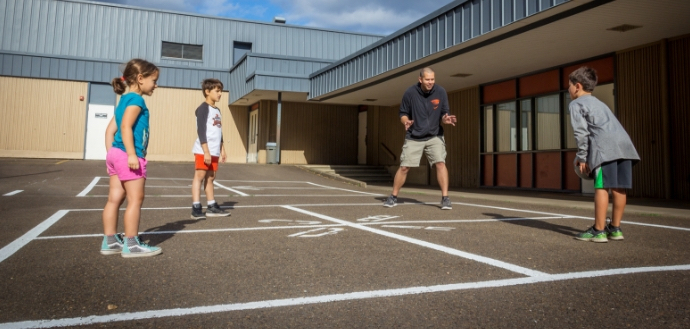
A new study suggests when adults are participants in school recess – leading games, monitoring play and ensuring conflicts are mediated quickly – children are more likely to be engaged in recess activities.
The study, which focused on the recess environment and student engagement during school recess periods, also found students were more likely to be active and engaged during longer recess periods; that boys were more engaged in recess than girls; and that recess provides more than a quarter of students’ school-based physical activity each day.
“This study underscores the importance of a high quality recess experience for children, including the need for adults who are actively engaged with the children on the playground,” says William Massey, an assistant professor in OSU’s College of Public Health and Human Sciences and lead author of the study.
“While recess is often perceived as a break for students and teachers alike, recess can also be an opportunity for teachers and students to interact in more informal settings, for teachers to model healthy behavior and appropriate social skills and for students and teachers to develop stronger relationships,” William says. “Importantly, other research has shown these factors contribute to student success.”
William’s findings were published recently in the journal Preventive Medicine Reports. Co-authors of the study are Megan Stellino of the University of Northern Colorado and Margaret Fraser of Concordia University Wisconsin.
Recess is seen by educators and policymakers as a valuable part of a child’s school day, in part because physical activity plays an important role in helping to curb high child obesity rates.
The Academy of Pediatrics, for example, has deemed recess as essential, and some states are now mandating recess in schools, William says. But many states have no standard recess requirement and children in urban, low-income schools are less likely to have opportunities for physical activity.
In the new study, William and his colleagues examined several variables that affect both a child’s engagement in recess activities and the amount of physical activity they netted during recess periods.
“If kids are active in a way that is not conducive to development, such as bullying or fighting, then just looking at how much time they spend being active misses an important part of the story,” says William, whose research interests include the implications of play, sports and other physical activity on youth development, particularly in urban and low-income areas. “Quality and quantity are both important when it comes to recess.”
William and his colleagues outfitted 146 children in grades 4-6 from seven schools with fitness tracking devices to monitor their physical activity during the school day, including recess. They also observed recess activity for 8,340 students at nine schools and analyzed the quality of the recess environment and the students’ engagement in activities.
They found that the average recess period was nearly 23 minutes and that students averaged just under 42 steps per minute during recess. The researchers also found that boys averaged about 10 more steps per minute than girls in each recess period.
Overall, recess contributed to 27 percent of the students’ daily step count average, even though it made up just 5.6 percent of the children’s school day. The findings also showed that the longer the recess time, the more steps per minute a child took and the more moderate to vigorous physical activity they engaged in.
“Interestingly, our data suggests that if you give children more time, they are more active with the time they have,” William says. “This finding supports recent efforts to extend recess to 30 minutes a day by states such as Florida, Arizona and New Jersey, in that shorter recess periods may not provide the opportunity to move in health-enhancing ways.”
The researchers also found that adult engagement and supervision during the recess period – adults actively participating in games and activities, making sure equipment is out and ready for use and ensuring conflicts are resolved quickly – is the strongest predictor of children’s engagement in recess activities.
“That suggests that adults are important role models and facilitators for children, especially in cases when children lack the social-emotional skills needed to navigate the recess environment,” William says. “This doesn’t mean that adults should dictate what children do during recess. It means recess should be viewed as a continuation of the school day in which children can play, interact and learn in a natural environment.”
The study provides new insight into some factors that may shape the school recess experience, but more research is needed to better understand how both the quality and quantity of recess affect children during the school day, he said.
The study was funded by a research grant from Playworks Education Energized, a national non-profit organization with a mission to support safe and healthy play in schools.